PGCE International: Bangalore Cohort - Ideal Classroom Design
VerifiedAdded on 2021/06/18
|14
|4560
|117
Essay
AI Summary
This essay, written for the PGCE International program in Bangalore, explores the characteristics of an ideal classroom within an ideal school setting. The author emphasizes student happiness, physical activity, and a student-centric curriculum as core elements. The essay delves into curriculum design, advocating for a balance between academics and physical activities, incorporating the 'flow' concept to enhance student engagement. It also highlights the importance of creating a child-centered environment that fosters holistic development, encompassing emotional and social literacy, and resilience. The author suggests practical strategies, such as incorporating physical activities into lessons, fostering positive relationships, and setting clear goals to optimize the learning experience. The essay underlines the significance of adapting teaching methods to meet individual student needs and creating a supportive environment that promotes both academic success and overall well-being, aligning with the principles of the ideal school model.
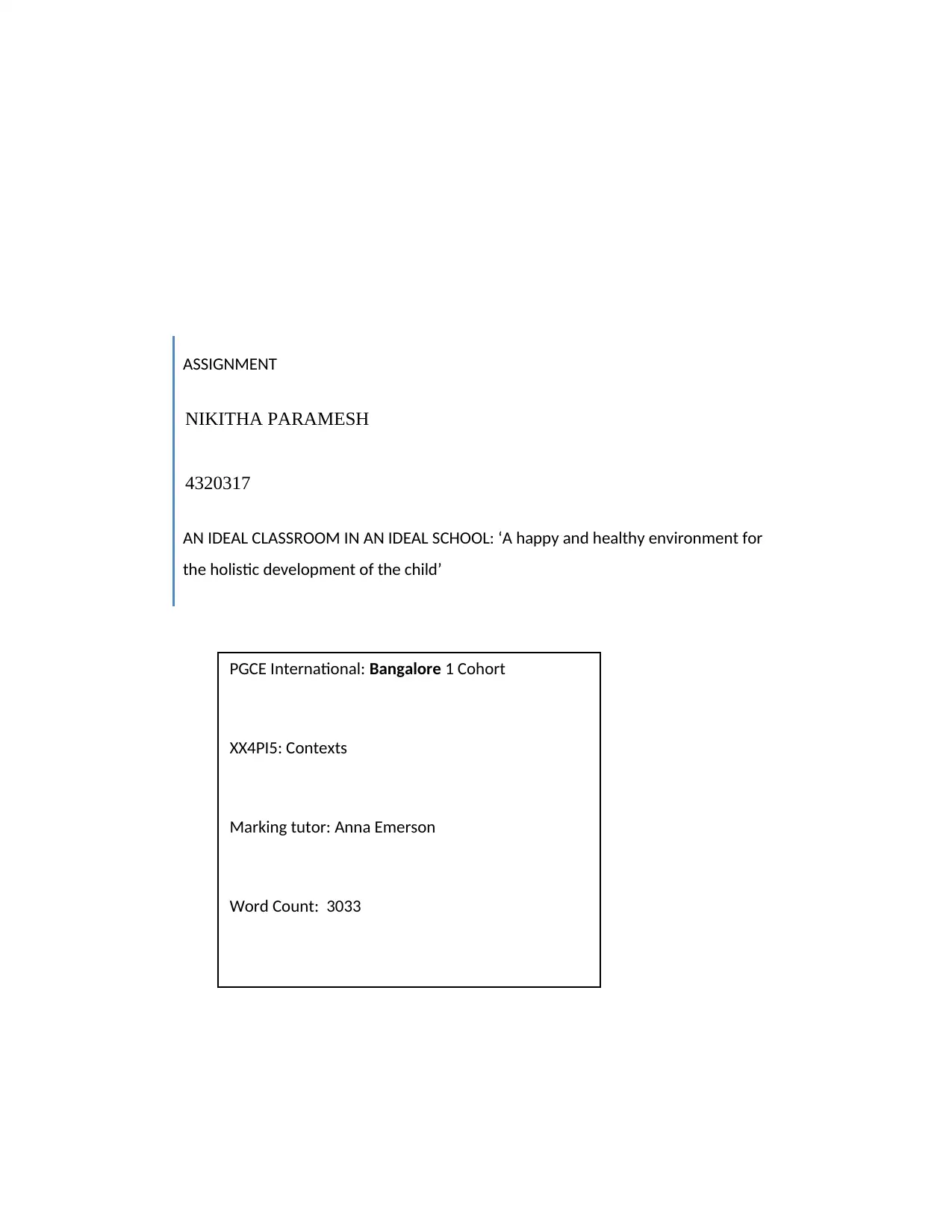
PGCE International: Bangalore 1 Cohort
XX4PI5: Contexts
Marking tutor: Anna Emerson
Word Count: 3033
ASSIGNMENT
NIKITHA PARAMESH
4320317
AN IDEAL CLASSROOM IN AN IDEAL SCHOOL: ‘A happy and healthy environment for
the holistic development of the child’
XX4PI5: Contexts
Marking tutor: Anna Emerson
Word Count: 3033
ASSIGNMENT
NIKITHA PARAMESH
4320317
AN IDEAL CLASSROOM IN AN IDEAL SCHOOL: ‘A happy and healthy environment for
the holistic development of the child’
Paraphrase This Document
Need a fresh take? Get an instant paraphrase of this document with our AI Paraphraser
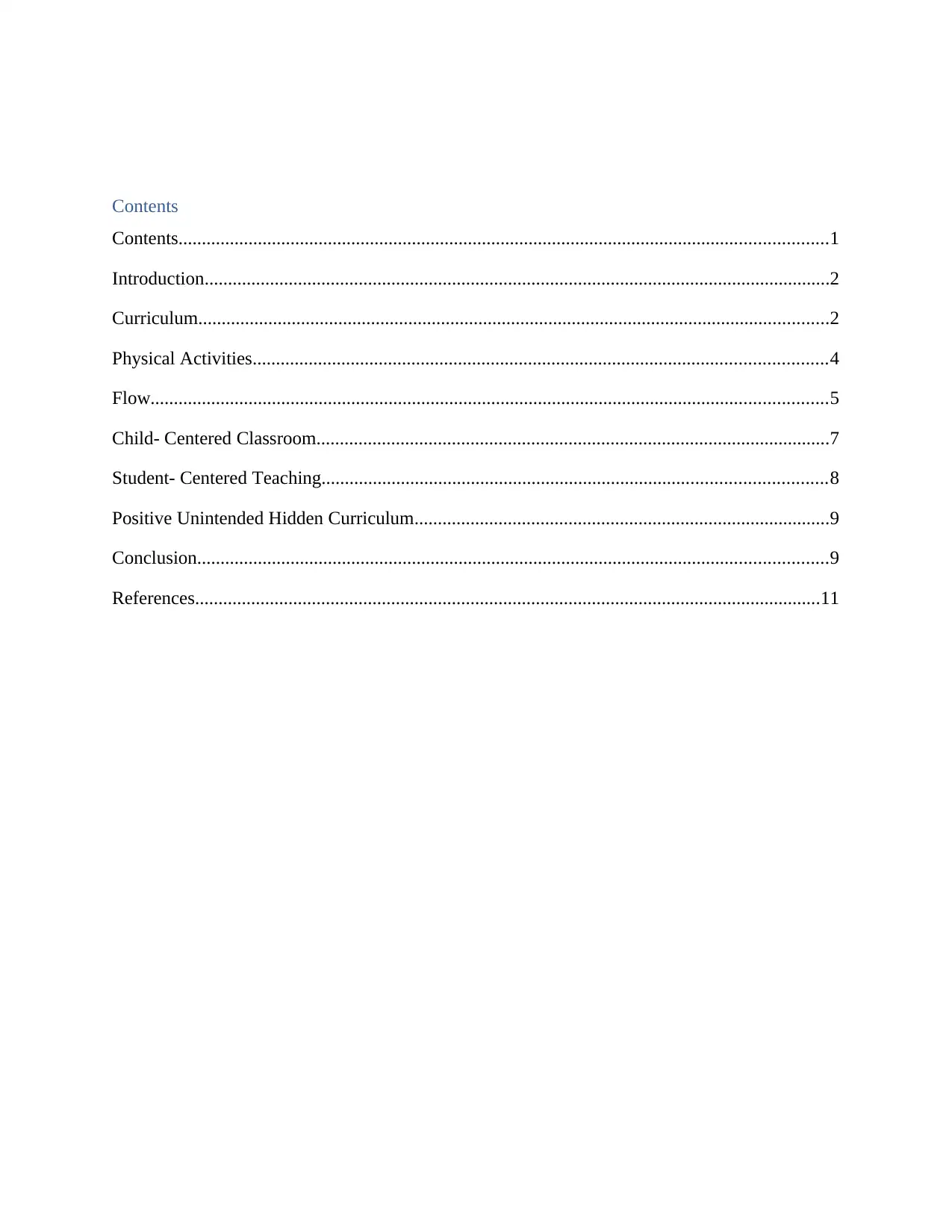
Contents
Contents...........................................................................................................................................1
Introduction......................................................................................................................................2
Curriculum.......................................................................................................................................2
Physical Activities...........................................................................................................................4
Flow.................................................................................................................................................5
Child- Centered Classroom..............................................................................................................7
Student- Centered Teaching............................................................................................................8
Positive Unintended Hidden Curriculum.........................................................................................9
Conclusion.......................................................................................................................................9
References......................................................................................................................................11
Contents...........................................................................................................................................1
Introduction......................................................................................................................................2
Curriculum.......................................................................................................................................2
Physical Activities...........................................................................................................................4
Flow.................................................................................................................................................5
Child- Centered Classroom..............................................................................................................7
Student- Centered Teaching............................................................................................................8
Positive Unintended Hidden Curriculum.........................................................................................9
Conclusion.......................................................................................................................................9
References......................................................................................................................................11
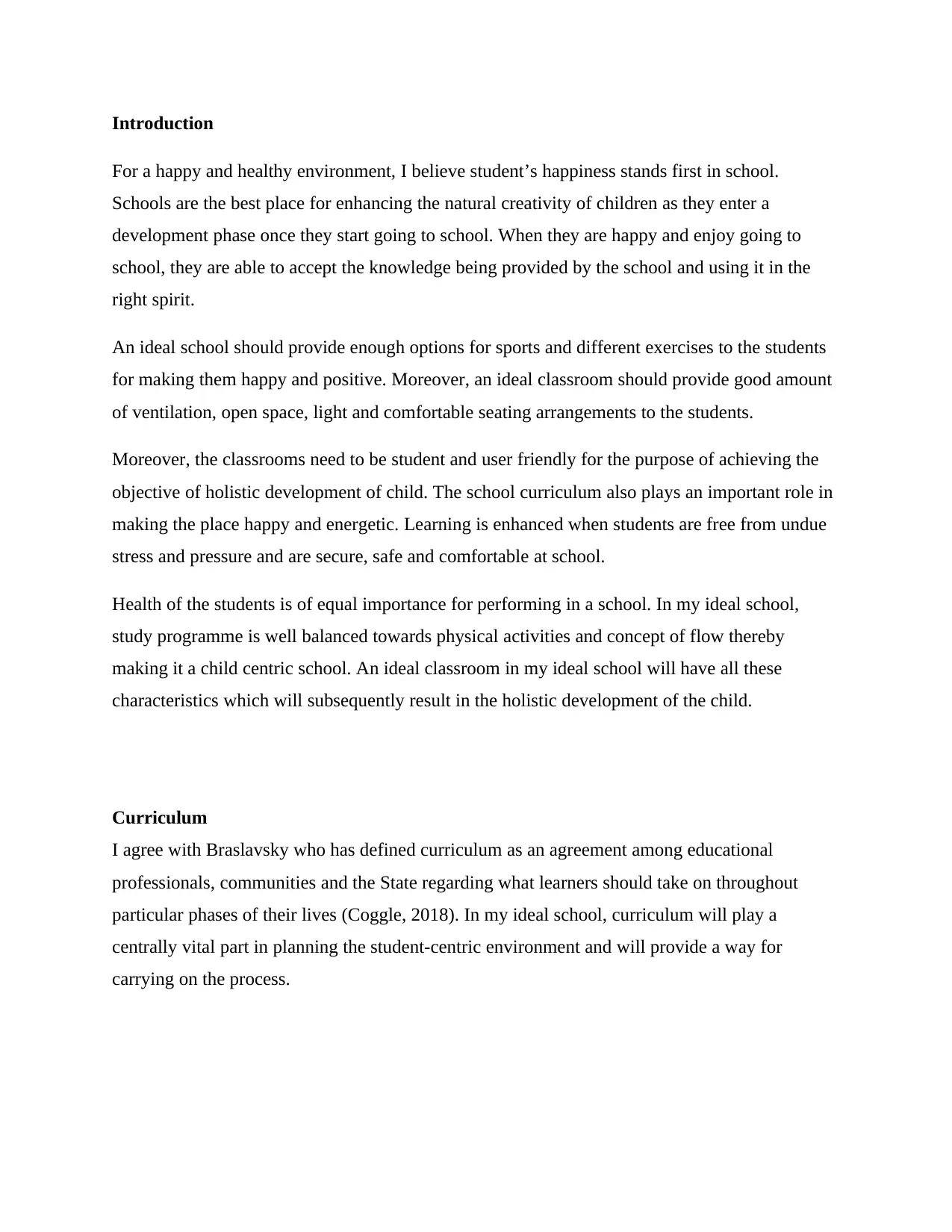
Introduction
For a happy and healthy environment, I believe student’s happiness stands first in school.
Schools are the best place for enhancing the natural creativity of children as they enter a
development phase once they start going to school. When they are happy and enjoy going to
school, they are able to accept the knowledge being provided by the school and using it in the
right spirit.
An ideal school should provide enough options for sports and different exercises to the students
for making them happy and positive. Moreover, an ideal classroom should provide good amount
of ventilation, open space, light and comfortable seating arrangements to the students.
Moreover, the classrooms need to be student and user friendly for the purpose of achieving the
objective of holistic development of child. The school curriculum also plays an important role in
making the place happy and energetic. Learning is enhanced when students are free from undue
stress and pressure and are secure, safe and comfortable at school.
Health of the students is of equal importance for performing in a school. In my ideal school,
study programme is well balanced towards physical activities and concept of flow thereby
making it a child centric school. An ideal classroom in my ideal school will have all these
characteristics which will subsequently result in the holistic development of the child.
Curriculum
I agree with Braslavsky who has defined curriculum as an agreement among educational
professionals, communities and the State regarding what learners should take on throughout
particular phases of their lives (Coggle, 2018). In my ideal school, curriculum will play a
centrally vital part in planning the student-centric environment and will provide a way for
carrying on the process.
For a happy and healthy environment, I believe student’s happiness stands first in school.
Schools are the best place for enhancing the natural creativity of children as they enter a
development phase once they start going to school. When they are happy and enjoy going to
school, they are able to accept the knowledge being provided by the school and using it in the
right spirit.
An ideal school should provide enough options for sports and different exercises to the students
for making them happy and positive. Moreover, an ideal classroom should provide good amount
of ventilation, open space, light and comfortable seating arrangements to the students.
Moreover, the classrooms need to be student and user friendly for the purpose of achieving the
objective of holistic development of child. The school curriculum also plays an important role in
making the place happy and energetic. Learning is enhanced when students are free from undue
stress and pressure and are secure, safe and comfortable at school.
Health of the students is of equal importance for performing in a school. In my ideal school,
study programme is well balanced towards physical activities and concept of flow thereby
making it a child centric school. An ideal classroom in my ideal school will have all these
characteristics which will subsequently result in the holistic development of the child.
Curriculum
I agree with Braslavsky who has defined curriculum as an agreement among educational
professionals, communities and the State regarding what learners should take on throughout
particular phases of their lives (Coggle, 2018). In my ideal school, curriculum will play a
centrally vital part in planning the student-centric environment and will provide a way for
carrying on the process.
⊘ This is a preview!⊘
Do you want full access?
Subscribe today to unlock all pages.

Trusted by 1+ million students worldwide
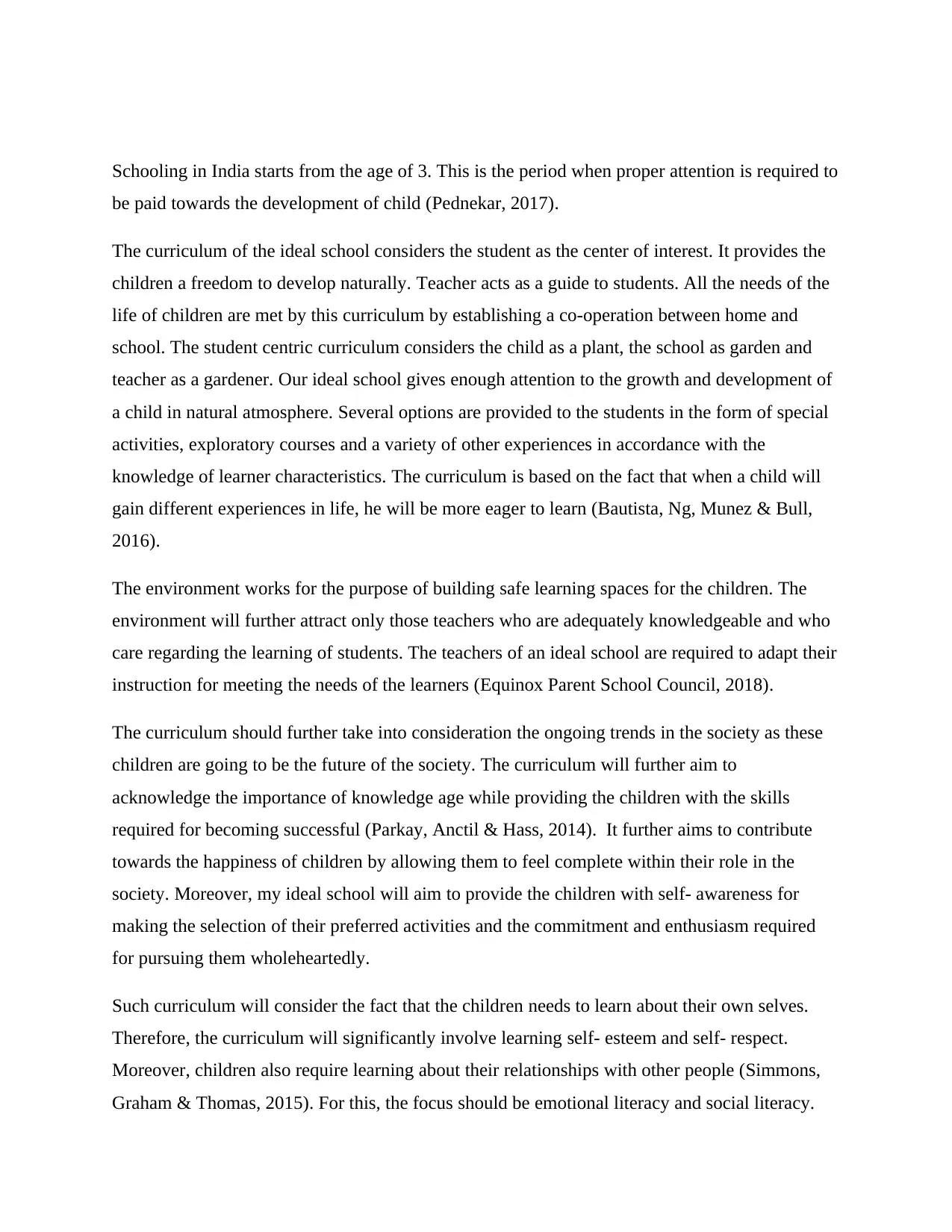
Schooling in India starts from the age of 3. This is the period when proper attention is required to
be paid towards the development of child (Pednekar, 2017).
The curriculum of the ideal school considers the student as the center of interest. It provides the
children a freedom to develop naturally. Teacher acts as a guide to students. All the needs of the
life of children are met by this curriculum by establishing a co-operation between home and
school. The student centric curriculum considers the child as a plant, the school as garden and
teacher as a gardener. Our ideal school gives enough attention to the growth and development of
a child in natural atmosphere. Several options are provided to the students in the form of special
activities, exploratory courses and a variety of other experiences in accordance with the
knowledge of learner characteristics. The curriculum is based on the fact that when a child will
gain different experiences in life, he will be more eager to learn (Bautista, Ng, Munez & Bull,
2016).
The environment works for the purpose of building safe learning spaces for the children. The
environment will further attract only those teachers who are adequately knowledgeable and who
care regarding the learning of students. The teachers of an ideal school are required to adapt their
instruction for meeting the needs of the learners (Equinox Parent School Council, 2018).
The curriculum should further take into consideration the ongoing trends in the society as these
children are going to be the future of the society. The curriculum will further aim to
acknowledge the importance of knowledge age while providing the children with the skills
required for becoming successful (Parkay, Anctil & Hass, 2014). It further aims to contribute
towards the happiness of children by allowing them to feel complete within their role in the
society. Moreover, my ideal school will aim to provide the children with self- awareness for
making the selection of their preferred activities and the commitment and enthusiasm required
for pursuing them wholeheartedly.
Such curriculum will consider the fact that the children needs to learn about their own selves.
Therefore, the curriculum will significantly involve learning self- esteem and self- respect.
Moreover, children also require learning about their relationships with other people (Simmons,
Graham & Thomas, 2015). For this, the focus should be emotional literacy and social literacy.
be paid towards the development of child (Pednekar, 2017).
The curriculum of the ideal school considers the student as the center of interest. It provides the
children a freedom to develop naturally. Teacher acts as a guide to students. All the needs of the
life of children are met by this curriculum by establishing a co-operation between home and
school. The student centric curriculum considers the child as a plant, the school as garden and
teacher as a gardener. Our ideal school gives enough attention to the growth and development of
a child in natural atmosphere. Several options are provided to the students in the form of special
activities, exploratory courses and a variety of other experiences in accordance with the
knowledge of learner characteristics. The curriculum is based on the fact that when a child will
gain different experiences in life, he will be more eager to learn (Bautista, Ng, Munez & Bull,
2016).
The environment works for the purpose of building safe learning spaces for the children. The
environment will further attract only those teachers who are adequately knowledgeable and who
care regarding the learning of students. The teachers of an ideal school are required to adapt their
instruction for meeting the needs of the learners (Equinox Parent School Council, 2018).
The curriculum should further take into consideration the ongoing trends in the society as these
children are going to be the future of the society. The curriculum will further aim to
acknowledge the importance of knowledge age while providing the children with the skills
required for becoming successful (Parkay, Anctil & Hass, 2014). It further aims to contribute
towards the happiness of children by allowing them to feel complete within their role in the
society. Moreover, my ideal school will aim to provide the children with self- awareness for
making the selection of their preferred activities and the commitment and enthusiasm required
for pursuing them wholeheartedly.
Such curriculum will consider the fact that the children needs to learn about their own selves.
Therefore, the curriculum will significantly involve learning self- esteem and self- respect.
Moreover, children also require learning about their relationships with other people (Simmons,
Graham & Thomas, 2015). For this, the focus should be emotional literacy and social literacy.
Paraphrase This Document
Need a fresh take? Get an instant paraphrase of this document with our AI Paraphraser
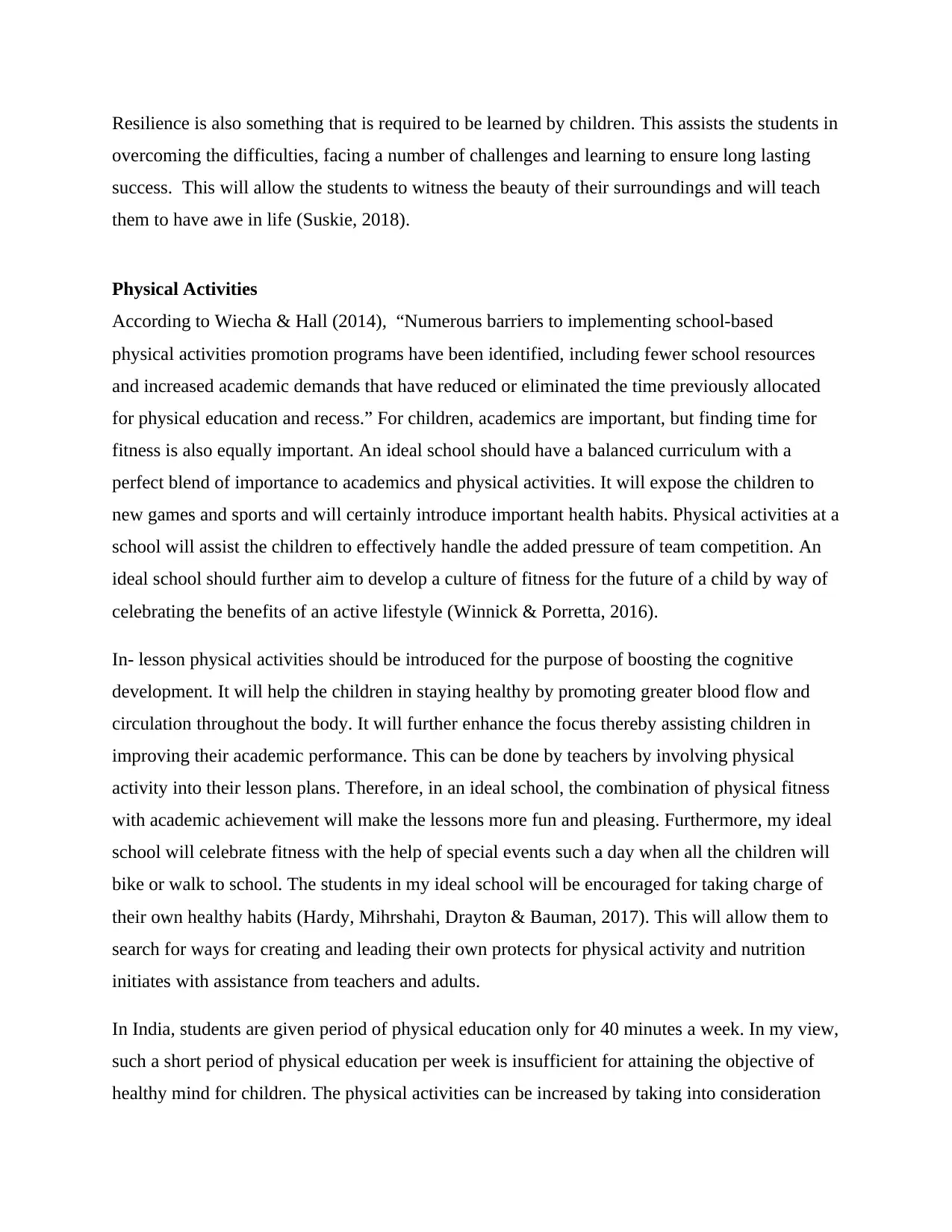
Resilience is also something that is required to be learned by children. This assists the students in
overcoming the difficulties, facing a number of challenges and learning to ensure long lasting
success. This will allow the students to witness the beauty of their surroundings and will teach
them to have awe in life (Suskie, 2018).
Physical Activities
According to Wiecha & Hall (2014), “Numerous barriers to implementing school-based
physical activities promotion programs have been identified, including fewer school resources
and increased academic demands that have reduced or eliminated the time previously allocated
for physical education and recess.” For children, academics are important, but finding time for
fitness is also equally important. An ideal school should have a balanced curriculum with a
perfect blend of importance to academics and physical activities. It will expose the children to
new games and sports and will certainly introduce important health habits. Physical activities at a
school will assist the children to effectively handle the added pressure of team competition. An
ideal school should further aim to develop a culture of fitness for the future of a child by way of
celebrating the benefits of an active lifestyle (Winnick & Porretta, 2016).
In- lesson physical activities should be introduced for the purpose of boosting the cognitive
development. It will help the children in staying healthy by promoting greater blood flow and
circulation throughout the body. It will further enhance the focus thereby assisting children in
improving their academic performance. This can be done by teachers by involving physical
activity into their lesson plans. Therefore, in an ideal school, the combination of physical fitness
with academic achievement will make the lessons more fun and pleasing. Furthermore, my ideal
school will celebrate fitness with the help of special events such a day when all the children will
bike or walk to school. The students in my ideal school will be encouraged for taking charge of
their own healthy habits (Hardy, Mihrshahi, Drayton & Bauman, 2017). This will allow them to
search for ways for creating and leading their own protects for physical activity and nutrition
initiates with assistance from teachers and adults.
In India, students are given period of physical education only for 40 minutes a week. In my view,
such a short period of physical education per week is insufficient for attaining the objective of
healthy mind for children. The physical activities can be increased by taking into consideration
overcoming the difficulties, facing a number of challenges and learning to ensure long lasting
success. This will allow the students to witness the beauty of their surroundings and will teach
them to have awe in life (Suskie, 2018).
Physical Activities
According to Wiecha & Hall (2014), “Numerous barriers to implementing school-based
physical activities promotion programs have been identified, including fewer school resources
and increased academic demands that have reduced or eliminated the time previously allocated
for physical education and recess.” For children, academics are important, but finding time for
fitness is also equally important. An ideal school should have a balanced curriculum with a
perfect blend of importance to academics and physical activities. It will expose the children to
new games and sports and will certainly introduce important health habits. Physical activities at a
school will assist the children to effectively handle the added pressure of team competition. An
ideal school should further aim to develop a culture of fitness for the future of a child by way of
celebrating the benefits of an active lifestyle (Winnick & Porretta, 2016).
In- lesson physical activities should be introduced for the purpose of boosting the cognitive
development. It will help the children in staying healthy by promoting greater blood flow and
circulation throughout the body. It will further enhance the focus thereby assisting children in
improving their academic performance. This can be done by teachers by involving physical
activity into their lesson plans. Therefore, in an ideal school, the combination of physical fitness
with academic achievement will make the lessons more fun and pleasing. Furthermore, my ideal
school will celebrate fitness with the help of special events such a day when all the children will
bike or walk to school. The students in my ideal school will be encouraged for taking charge of
their own healthy habits (Hardy, Mihrshahi, Drayton & Bauman, 2017). This will allow them to
search for ways for creating and leading their own protects for physical activity and nutrition
initiates with assistance from teachers and adults.
In India, students are given period of physical education only for 40 minutes a week. In my view,
such a short period of physical education per week is insufficient for attaining the objective of
healthy mind for children. The physical activities can be increased by taking into consideration
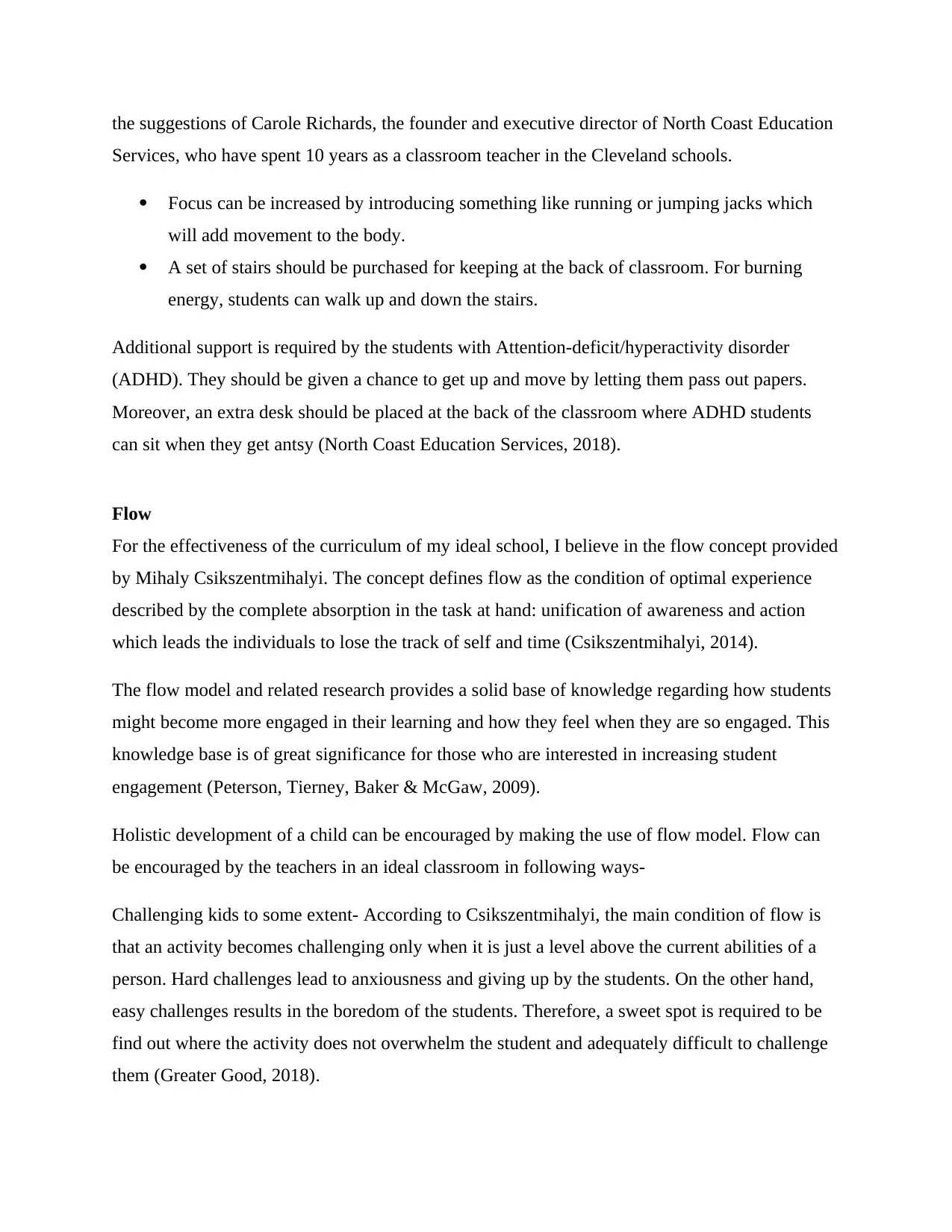
the suggestions of Carole Richards, the founder and executive director of North Coast Education
Services, who have spent 10 years as a classroom teacher in the Cleveland schools.
Focus can be increased by introducing something like running or jumping jacks which
will add movement to the body.
A set of stairs should be purchased for keeping at the back of classroom. For burning
energy, students can walk up and down the stairs.
Additional support is required by the students with Attention-deficit/hyperactivity disorder
(ADHD). They should be given a chance to get up and move by letting them pass out papers.
Moreover, an extra desk should be placed at the back of the classroom where ADHD students
can sit when they get antsy (North Coast Education Services, 2018).
Flow
For the effectiveness of the curriculum of my ideal school, I believe in the flow concept provided
by Mihaly Csikszentmihalyi. The concept defines flow as the condition of optimal experience
described by the complete absorption in the task at hand: unification of awareness and action
which leads the individuals to lose the track of self and time (Csikszentmihalyi, 2014).
The flow model and related research provides a solid base of knowledge regarding how students
might become more engaged in their learning and how they feel when they are so engaged. This
knowledge base is of great significance for those who are interested in increasing student
engagement (Peterson, Tierney, Baker & McGaw, 2009).
Holistic development of a child can be encouraged by making the use of flow model. Flow can
be encouraged by the teachers in an ideal classroom in following ways-
Challenging kids to some extent- According to Csikszentmihalyi, the main condition of flow is
that an activity becomes challenging only when it is just a level above the current abilities of a
person. Hard challenges lead to anxiousness and giving up by the students. On the other hand,
easy challenges results in the boredom of the students. Therefore, a sweet spot is required to be
find out where the activity does not overwhelm the student and adequately difficult to challenge
them (Greater Good, 2018).
Services, who have spent 10 years as a classroom teacher in the Cleveland schools.
Focus can be increased by introducing something like running or jumping jacks which
will add movement to the body.
A set of stairs should be purchased for keeping at the back of classroom. For burning
energy, students can walk up and down the stairs.
Additional support is required by the students with Attention-deficit/hyperactivity disorder
(ADHD). They should be given a chance to get up and move by letting them pass out papers.
Moreover, an extra desk should be placed at the back of the classroom where ADHD students
can sit when they get antsy (North Coast Education Services, 2018).
Flow
For the effectiveness of the curriculum of my ideal school, I believe in the flow concept provided
by Mihaly Csikszentmihalyi. The concept defines flow as the condition of optimal experience
described by the complete absorption in the task at hand: unification of awareness and action
which leads the individuals to lose the track of self and time (Csikszentmihalyi, 2014).
The flow model and related research provides a solid base of knowledge regarding how students
might become more engaged in their learning and how they feel when they are so engaged. This
knowledge base is of great significance for those who are interested in increasing student
engagement (Peterson, Tierney, Baker & McGaw, 2009).
Holistic development of a child can be encouraged by making the use of flow model. Flow can
be encouraged by the teachers in an ideal classroom in following ways-
Challenging kids to some extent- According to Csikszentmihalyi, the main condition of flow is
that an activity becomes challenging only when it is just a level above the current abilities of a
person. Hard challenges lead to anxiousness and giving up by the students. On the other hand,
easy challenges results in the boredom of the students. Therefore, a sweet spot is required to be
find out where the activity does not overwhelm the student and adequately difficult to challenge
them (Greater Good, 2018).
⊘ This is a preview!⊘
Do you want full access?
Subscribe today to unlock all pages.

Trusted by 1+ million students worldwide
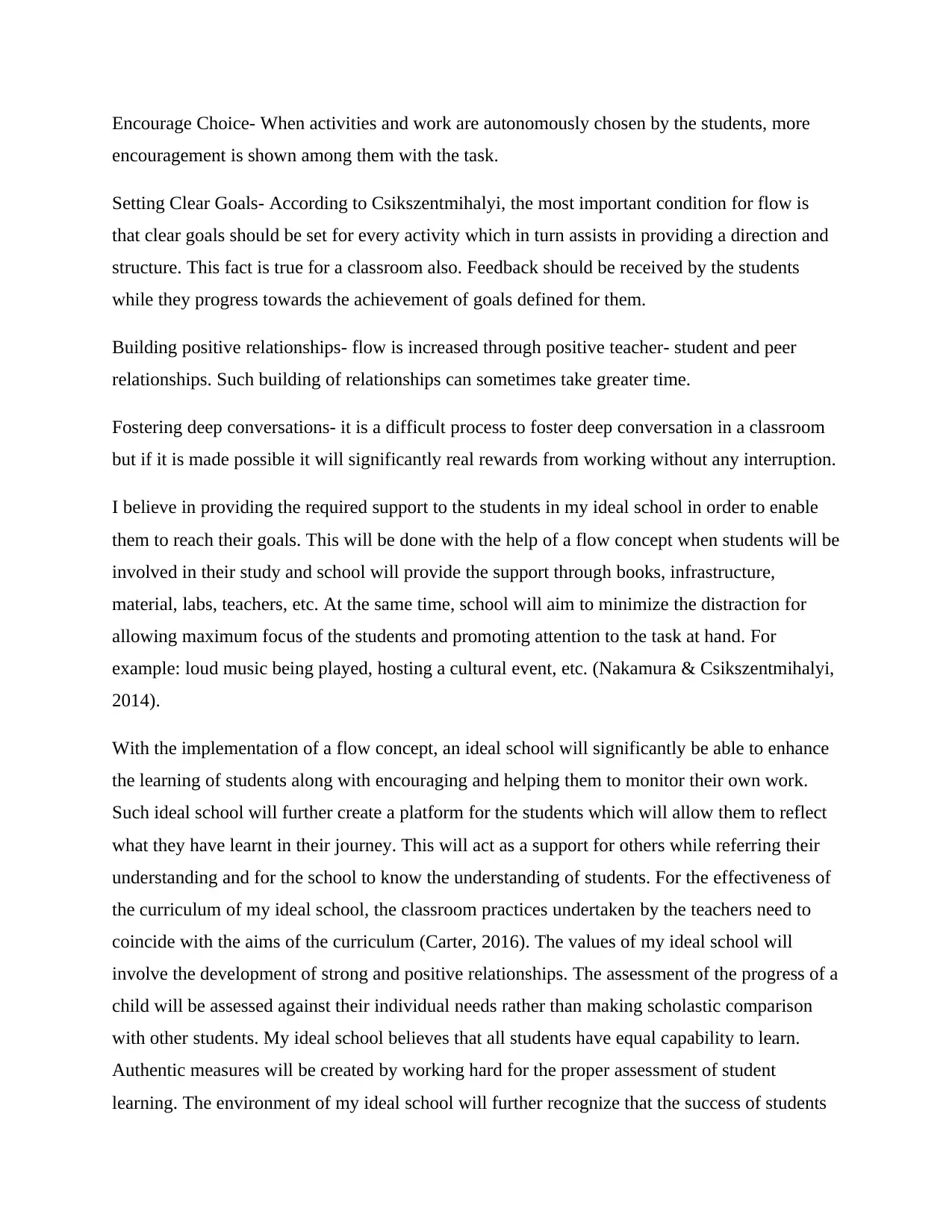
Encourage Choice- When activities and work are autonomously chosen by the students, more
encouragement is shown among them with the task.
Setting Clear Goals- According to Csikszentmihalyi, the most important condition for flow is
that clear goals should be set for every activity which in turn assists in providing a direction and
structure. This fact is true for a classroom also. Feedback should be received by the students
while they progress towards the achievement of goals defined for them.
Building positive relationships- flow is increased through positive teacher- student and peer
relationships. Such building of relationships can sometimes take greater time.
Fostering deep conversations- it is a difficult process to foster deep conversation in a classroom
but if it is made possible it will significantly real rewards from working without any interruption.
I believe in providing the required support to the students in my ideal school in order to enable
them to reach their goals. This will be done with the help of a flow concept when students will be
involved in their study and school will provide the support through books, infrastructure,
material, labs, teachers, etc. At the same time, school will aim to minimize the distraction for
allowing maximum focus of the students and promoting attention to the task at hand. For
example: loud music being played, hosting a cultural event, etc. (Nakamura & Csikszentmihalyi,
2014).
With the implementation of a flow concept, an ideal school will significantly be able to enhance
the learning of students along with encouraging and helping them to monitor their own work.
Such ideal school will further create a platform for the students which will allow them to reflect
what they have learnt in their journey. This will act as a support for others while referring their
understanding and for the school to know the understanding of students. For the effectiveness of
the curriculum of my ideal school, the classroom practices undertaken by the teachers need to
coincide with the aims of the curriculum (Carter, 2016). The values of my ideal school will
involve the development of strong and positive relationships. The assessment of the progress of a
child will be assessed against their individual needs rather than making scholastic comparison
with other students. My ideal school believes that all students have equal capability to learn.
Authentic measures will be created by working hard for the proper assessment of student
learning. The environment of my ideal school will further recognize that the success of students
encouragement is shown among them with the task.
Setting Clear Goals- According to Csikszentmihalyi, the most important condition for flow is
that clear goals should be set for every activity which in turn assists in providing a direction and
structure. This fact is true for a classroom also. Feedback should be received by the students
while they progress towards the achievement of goals defined for them.
Building positive relationships- flow is increased through positive teacher- student and peer
relationships. Such building of relationships can sometimes take greater time.
Fostering deep conversations- it is a difficult process to foster deep conversation in a classroom
but if it is made possible it will significantly real rewards from working without any interruption.
I believe in providing the required support to the students in my ideal school in order to enable
them to reach their goals. This will be done with the help of a flow concept when students will be
involved in their study and school will provide the support through books, infrastructure,
material, labs, teachers, etc. At the same time, school will aim to minimize the distraction for
allowing maximum focus of the students and promoting attention to the task at hand. For
example: loud music being played, hosting a cultural event, etc. (Nakamura & Csikszentmihalyi,
2014).
With the implementation of a flow concept, an ideal school will significantly be able to enhance
the learning of students along with encouraging and helping them to monitor their own work.
Such ideal school will further create a platform for the students which will allow them to reflect
what they have learnt in their journey. This will act as a support for others while referring their
understanding and for the school to know the understanding of students. For the effectiveness of
the curriculum of my ideal school, the classroom practices undertaken by the teachers need to
coincide with the aims of the curriculum (Carter, 2016). The values of my ideal school will
involve the development of strong and positive relationships. The assessment of the progress of a
child will be assessed against their individual needs rather than making scholastic comparison
with other students. My ideal school believes that all students have equal capability to learn.
Authentic measures will be created by working hard for the proper assessment of student
learning. The environment of my ideal school will further recognize that the success of students
Paraphrase This Document
Need a fresh take? Get an instant paraphrase of this document with our AI Paraphraser
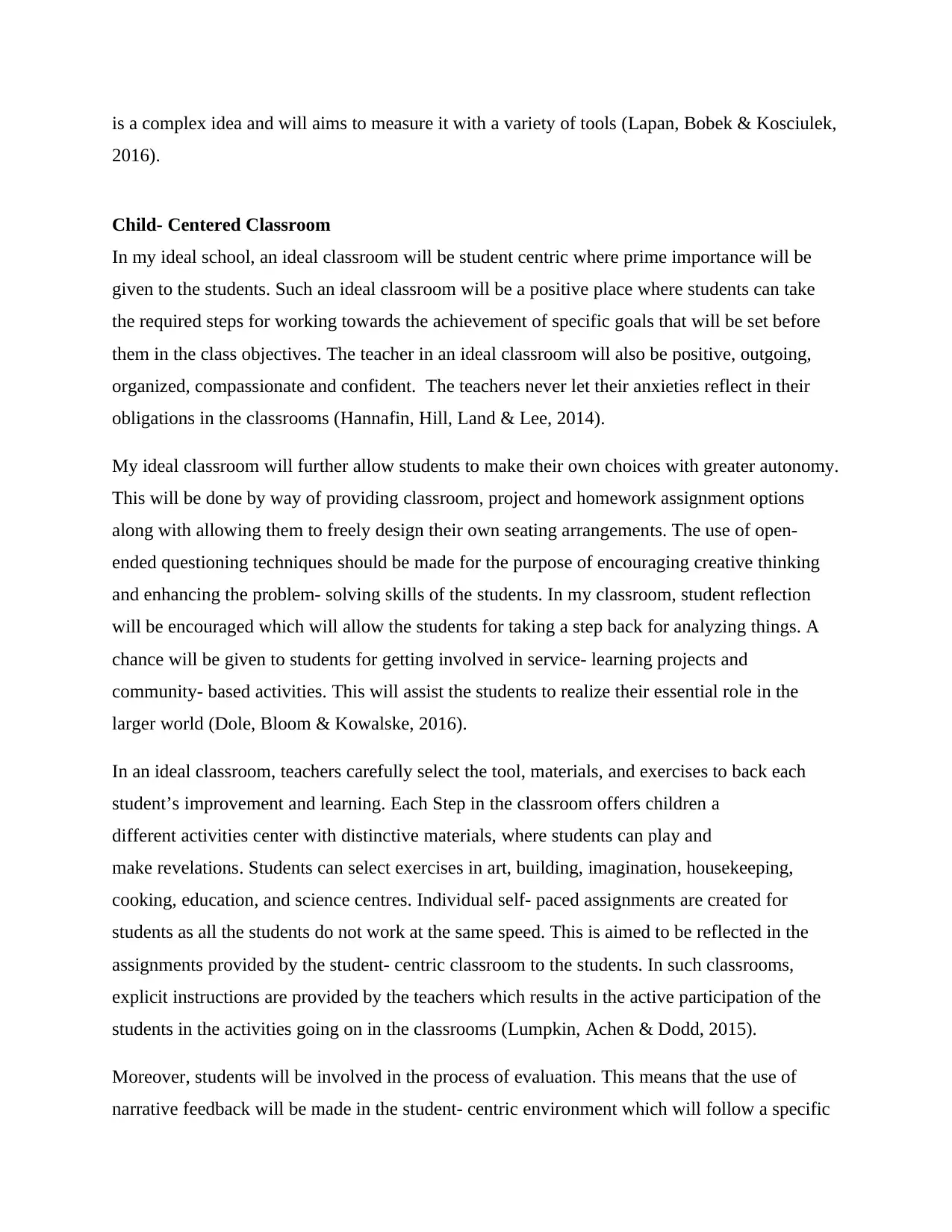
is a complex idea and will aims to measure it with a variety of tools (Lapan, Bobek & Kosciulek,
2016).
Child- Centered Classroom
In my ideal school, an ideal classroom will be student centric where prime importance will be
given to the students. Such an ideal classroom will be a positive place where students can take
the required steps for working towards the achievement of specific goals that will be set before
them in the class objectives. The teacher in an ideal classroom will also be positive, outgoing,
organized, compassionate and confident. The teachers never let their anxieties reflect in their
obligations in the classrooms (Hannafin, Hill, Land & Lee, 2014).
My ideal classroom will further allow students to make their own choices with greater autonomy.
This will be done by way of providing classroom, project and homework assignment options
along with allowing them to freely design their own seating arrangements. The use of open-
ended questioning techniques should be made for the purpose of encouraging creative thinking
and enhancing the problem- solving skills of the students. In my classroom, student reflection
will be encouraged which will allow the students for taking a step back for analyzing things. A
chance will be given to students for getting involved in service- learning projects and
community- based activities. This will assist the students to realize their essential role in the
larger world (Dole, Bloom & Kowalske, 2016).
In an ideal classroom, teachers carefully select the tool, materials, and exercises to back each
student’s improvement and learning. Each Step in the classroom offers children a
different activities center with distinctive materials, where students can play and
make revelations. Students can select exercises in art, building, imagination, housekeeping,
cooking, education, and science centres. Individual self- paced assignments are created for
students as all the students do not work at the same speed. This is aimed to be reflected in the
assignments provided by the student- centric classroom to the students. In such classrooms,
explicit instructions are provided by the teachers which results in the active participation of the
students in the activities going on in the classrooms (Lumpkin, Achen & Dodd, 2015).
Moreover, students will be involved in the process of evaluation. This means that the use of
narrative feedback will be made in the student- centric environment which will follow a specific
2016).
Child- Centered Classroom
In my ideal school, an ideal classroom will be student centric where prime importance will be
given to the students. Such an ideal classroom will be a positive place where students can take
the required steps for working towards the achievement of specific goals that will be set before
them in the class objectives. The teacher in an ideal classroom will also be positive, outgoing,
organized, compassionate and confident. The teachers never let their anxieties reflect in their
obligations in the classrooms (Hannafin, Hill, Land & Lee, 2014).
My ideal classroom will further allow students to make their own choices with greater autonomy.
This will be done by way of providing classroom, project and homework assignment options
along with allowing them to freely design their own seating arrangements. The use of open-
ended questioning techniques should be made for the purpose of encouraging creative thinking
and enhancing the problem- solving skills of the students. In my classroom, student reflection
will be encouraged which will allow the students for taking a step back for analyzing things. A
chance will be given to students for getting involved in service- learning projects and
community- based activities. This will assist the students to realize their essential role in the
larger world (Dole, Bloom & Kowalske, 2016).
In an ideal classroom, teachers carefully select the tool, materials, and exercises to back each
student’s improvement and learning. Each Step in the classroom offers children a
different activities center with distinctive materials, where students can play and
make revelations. Students can select exercises in art, building, imagination, housekeeping,
cooking, education, and science centres. Individual self- paced assignments are created for
students as all the students do not work at the same speed. This is aimed to be reflected in the
assignments provided by the student- centric classroom to the students. In such classrooms,
explicit instructions are provided by the teachers which results in the active participation of the
students in the activities going on in the classrooms (Lumpkin, Achen & Dodd, 2015).
Moreover, students will be involved in the process of evaluation. This means that the use of
narrative feedback will be made in the student- centric environment which will follow a specific
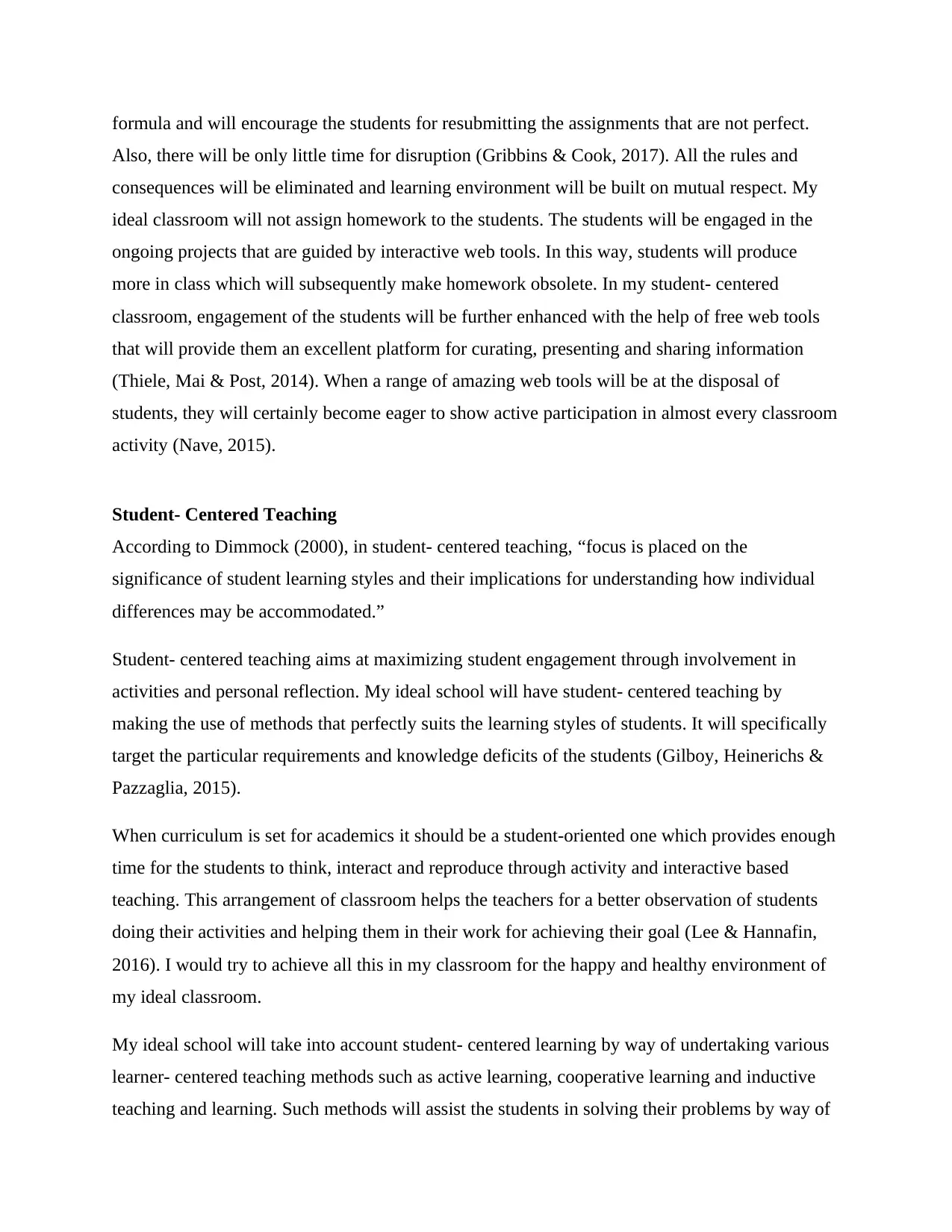
formula and will encourage the students for resubmitting the assignments that are not perfect.
Also, there will be only little time for disruption (Gribbins & Cook, 2017). All the rules and
consequences will be eliminated and learning environment will be built on mutual respect. My
ideal classroom will not assign homework to the students. The students will be engaged in the
ongoing projects that are guided by interactive web tools. In this way, students will produce
more in class which will subsequently make homework obsolete. In my student- centered
classroom, engagement of the students will be further enhanced with the help of free web tools
that will provide them an excellent platform for curating, presenting and sharing information
(Thiele, Mai & Post, 2014). When a range of amazing web tools will be at the disposal of
students, they will certainly become eager to show active participation in almost every classroom
activity (Nave, 2015).
Student- Centered Teaching
According to Dimmock (2000), in student- centered teaching, “focus is placed on the
significance of student learning styles and their implications for understanding how individual
differences may be accommodated.”
Student- centered teaching aims at maximizing student engagement through involvement in
activities and personal reflection. My ideal school will have student- centered teaching by
making the use of methods that perfectly suits the learning styles of students. It will specifically
target the particular requirements and knowledge deficits of the students (Gilboy, Heinerichs &
Pazzaglia, 2015).
When curriculum is set for academics it should be a student-oriented one which provides enough
time for the students to think, interact and reproduce through activity and interactive based
teaching. This arrangement of classroom helps the teachers for a better observation of students
doing their activities and helping them in their work for achieving their goal (Lee & Hannafin,
2016). I would try to achieve all this in my classroom for the happy and healthy environment of
my ideal classroom.
My ideal school will take into account student- centered learning by way of undertaking various
learner- centered teaching methods such as active learning, cooperative learning and inductive
teaching and learning. Such methods will assist the students in solving their problems by way of
Also, there will be only little time for disruption (Gribbins & Cook, 2017). All the rules and
consequences will be eliminated and learning environment will be built on mutual respect. My
ideal classroom will not assign homework to the students. The students will be engaged in the
ongoing projects that are guided by interactive web tools. In this way, students will produce
more in class which will subsequently make homework obsolete. In my student- centered
classroom, engagement of the students will be further enhanced with the help of free web tools
that will provide them an excellent platform for curating, presenting and sharing information
(Thiele, Mai & Post, 2014). When a range of amazing web tools will be at the disposal of
students, they will certainly become eager to show active participation in almost every classroom
activity (Nave, 2015).
Student- Centered Teaching
According to Dimmock (2000), in student- centered teaching, “focus is placed on the
significance of student learning styles and their implications for understanding how individual
differences may be accommodated.”
Student- centered teaching aims at maximizing student engagement through involvement in
activities and personal reflection. My ideal school will have student- centered teaching by
making the use of methods that perfectly suits the learning styles of students. It will specifically
target the particular requirements and knowledge deficits of the students (Gilboy, Heinerichs &
Pazzaglia, 2015).
When curriculum is set for academics it should be a student-oriented one which provides enough
time for the students to think, interact and reproduce through activity and interactive based
teaching. This arrangement of classroom helps the teachers for a better observation of students
doing their activities and helping them in their work for achieving their goal (Lee & Hannafin,
2016). I would try to achieve all this in my classroom for the happy and healthy environment of
my ideal classroom.
My ideal school will take into account student- centered learning by way of undertaking various
learner- centered teaching methods such as active learning, cooperative learning and inductive
teaching and learning. Such methods will assist the students in solving their problems by way of
⊘ This is a preview!⊘
Do you want full access?
Subscribe today to unlock all pages.

Trusted by 1+ million students worldwide
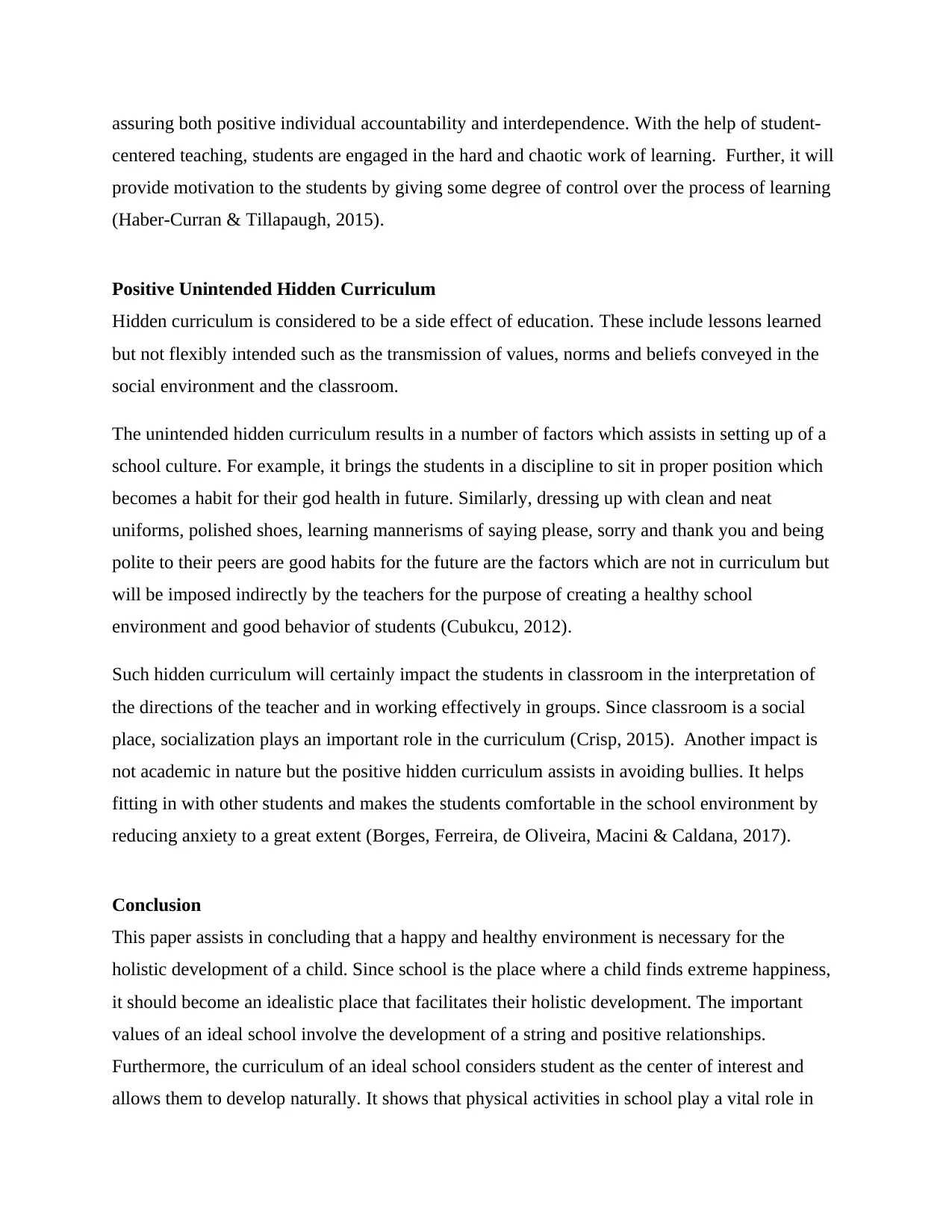
assuring both positive individual accountability and interdependence. With the help of student-
centered teaching, students are engaged in the hard and chaotic work of learning. Further, it will
provide motivation to the students by giving some degree of control over the process of learning
(Haber-Curran & Tillapaugh, 2015).
Positive Unintended Hidden Curriculum
Hidden curriculum is considered to be a side effect of education. These include lessons learned
but not flexibly intended such as the transmission of values, norms and beliefs conveyed in the
social environment and the classroom.
The unintended hidden curriculum results in a number of factors which assists in setting up of a
school culture. For example, it brings the students in a discipline to sit in proper position which
becomes a habit for their god health in future. Similarly, dressing up with clean and neat
uniforms, polished shoes, learning mannerisms of saying please, sorry and thank you and being
polite to their peers are good habits for the future are the factors which are not in curriculum but
will be imposed indirectly by the teachers for the purpose of creating a healthy school
environment and good behavior of students (Cubukcu, 2012).
Such hidden curriculum will certainly impact the students in classroom in the interpretation of
the directions of the teacher and in working effectively in groups. Since classroom is a social
place, socialization plays an important role in the curriculum (Crisp, 2015). Another impact is
not academic in nature but the positive hidden curriculum assists in avoiding bullies. It helps
fitting in with other students and makes the students comfortable in the school environment by
reducing anxiety to a great extent (Borges, Ferreira, de Oliveira, Macini & Caldana, 2017).
Conclusion
This paper assists in concluding that a happy and healthy environment is necessary for the
holistic development of a child. Since school is the place where a child finds extreme happiness,
it should become an idealistic place that facilitates their holistic development. The important
values of an ideal school involve the development of a string and positive relationships.
Furthermore, the curriculum of an ideal school considers student as the center of interest and
allows them to develop naturally. It shows that physical activities in school play a vital role in
centered teaching, students are engaged in the hard and chaotic work of learning. Further, it will
provide motivation to the students by giving some degree of control over the process of learning
(Haber-Curran & Tillapaugh, 2015).
Positive Unintended Hidden Curriculum
Hidden curriculum is considered to be a side effect of education. These include lessons learned
but not flexibly intended such as the transmission of values, norms and beliefs conveyed in the
social environment and the classroom.
The unintended hidden curriculum results in a number of factors which assists in setting up of a
school culture. For example, it brings the students in a discipline to sit in proper position which
becomes a habit for their god health in future. Similarly, dressing up with clean and neat
uniforms, polished shoes, learning mannerisms of saying please, sorry and thank you and being
polite to their peers are good habits for the future are the factors which are not in curriculum but
will be imposed indirectly by the teachers for the purpose of creating a healthy school
environment and good behavior of students (Cubukcu, 2012).
Such hidden curriculum will certainly impact the students in classroom in the interpretation of
the directions of the teacher and in working effectively in groups. Since classroom is a social
place, socialization plays an important role in the curriculum (Crisp, 2015). Another impact is
not academic in nature but the positive hidden curriculum assists in avoiding bullies. It helps
fitting in with other students and makes the students comfortable in the school environment by
reducing anxiety to a great extent (Borges, Ferreira, de Oliveira, Macini & Caldana, 2017).
Conclusion
This paper assists in concluding that a happy and healthy environment is necessary for the
holistic development of a child. Since school is the place where a child finds extreme happiness,
it should become an idealistic place that facilitates their holistic development. The important
values of an ideal school involve the development of a string and positive relationships.
Furthermore, the curriculum of an ideal school considers student as the center of interest and
allows them to develop naturally. It shows that physical activities in school play a vital role in
Paraphrase This Document
Need a fresh take? Get an instant paraphrase of this document with our AI Paraphraser
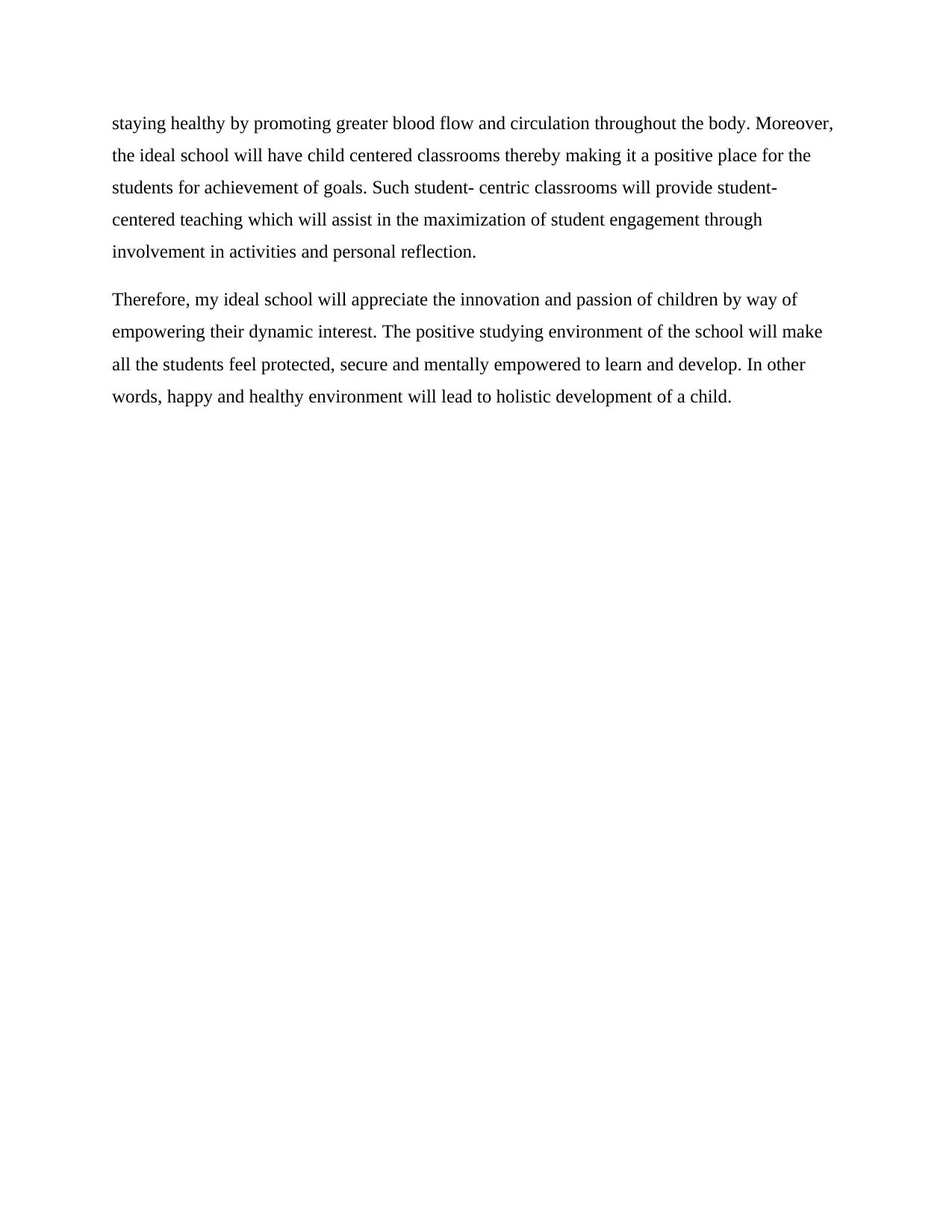
staying healthy by promoting greater blood flow and circulation throughout the body. Moreover,
the ideal school will have child centered classrooms thereby making it a positive place for the
students for achievement of goals. Such student- centric classrooms will provide student-
centered teaching which will assist in the maximization of student engagement through
involvement in activities and personal reflection.
Therefore, my ideal school will appreciate the innovation and passion of children by way of
empowering their dynamic interest. The positive studying environment of the school will make
all the students feel protected, secure and mentally empowered to learn and develop. In other
words, happy and healthy environment will lead to holistic development of a child.
the ideal school will have child centered classrooms thereby making it a positive place for the
students for achievement of goals. Such student- centric classrooms will provide student-
centered teaching which will assist in the maximization of student engagement through
involvement in activities and personal reflection.
Therefore, my ideal school will appreciate the innovation and passion of children by way of
empowering their dynamic interest. The positive studying environment of the school will make
all the students feel protected, secure and mentally empowered to learn and develop. In other
words, happy and healthy environment will lead to holistic development of a child.
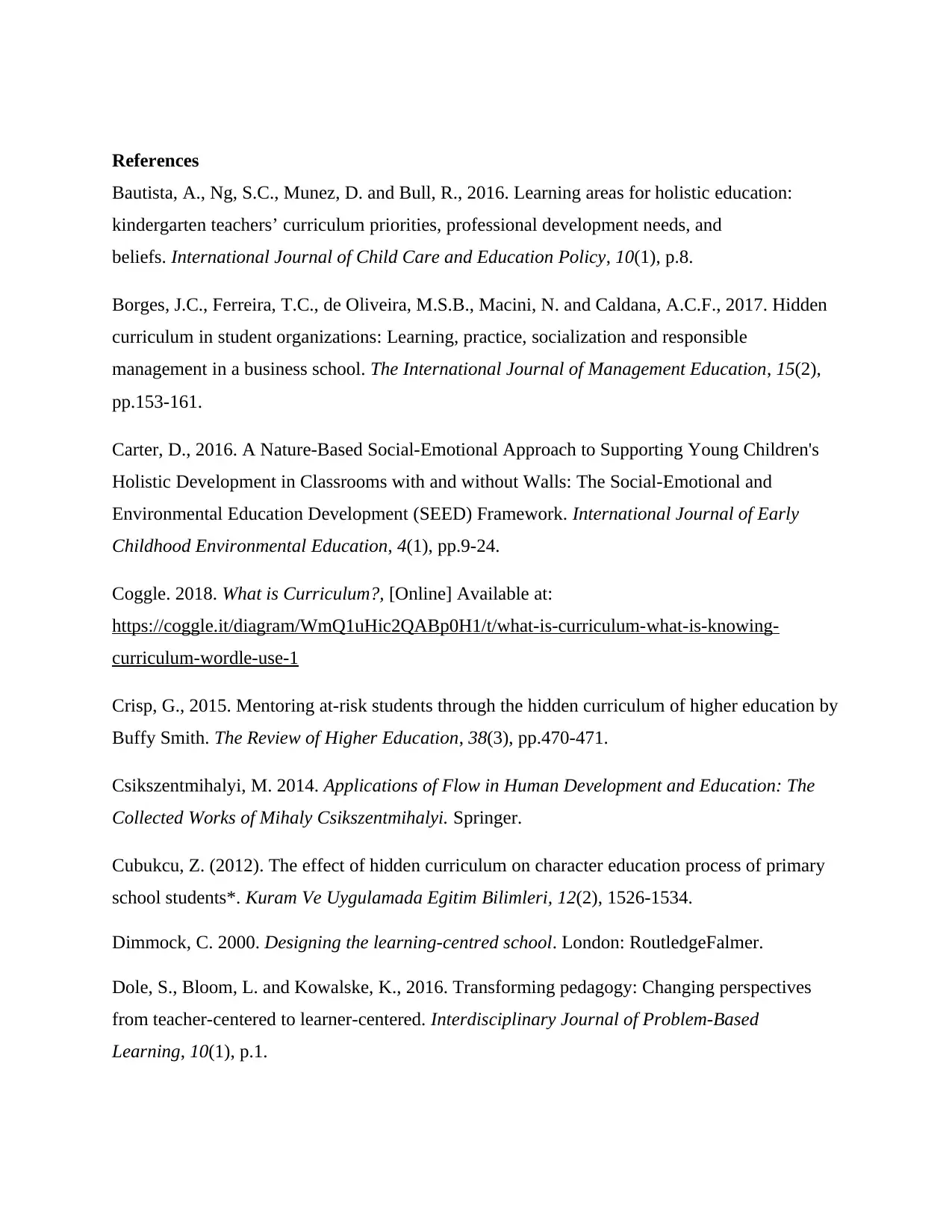
References
Bautista, A., Ng, S.C., Munez, D. and Bull, R., 2016. Learning areas for holistic education:
kindergarten teachers’ curriculum priorities, professional development needs, and
beliefs. International Journal of Child Care and Education Policy, 10(1), p.8.
Borges, J.C., Ferreira, T.C., de Oliveira, M.S.B., Macini, N. and Caldana, A.C.F., 2017. Hidden
curriculum in student organizations: Learning, practice, socialization and responsible
management in a business school. The International Journal of Management Education, 15(2),
pp.153-161.
Carter, D., 2016. A Nature-Based Social-Emotional Approach to Supporting Young Children's
Holistic Development in Classrooms with and without Walls: The Social-Emotional and
Environmental Education Development (SEED) Framework. International Journal of Early
Childhood Environmental Education, 4(1), pp.9-24.
Coggle. 2018. What is Curriculum?, [Online] Available at:
https://coggle.it/diagram/WmQ1uHic2QABp0H1/t/what-is-curriculum-what-is-knowing-
curriculum-wordle-use-1
Crisp, G., 2015. Mentoring at-risk students through the hidden curriculum of higher education by
Buffy Smith. The Review of Higher Education, 38(3), pp.470-471.
Csikszentmihalyi, M. 2014. Applications of Flow in Human Development and Education: The
Collected Works of Mihaly Csikszentmihalyi. Springer.
Cubukcu, Z. (2012). The effect of hidden curriculum on character education process of primary
school students*. Kuram Ve Uygulamada Egitim Bilimleri, 12(2), 1526-1534.
Dimmock, C. 2000. Designing the learning-centred school. London: RoutledgeFalmer.
Dole, S., Bloom, L. and Kowalske, K., 2016. Transforming pedagogy: Changing perspectives
from teacher-centered to learner-centered. Interdisciplinary Journal of Problem-Based
Learning, 10(1), p.1.
Bautista, A., Ng, S.C., Munez, D. and Bull, R., 2016. Learning areas for holistic education:
kindergarten teachers’ curriculum priorities, professional development needs, and
beliefs. International Journal of Child Care and Education Policy, 10(1), p.8.
Borges, J.C., Ferreira, T.C., de Oliveira, M.S.B., Macini, N. and Caldana, A.C.F., 2017. Hidden
curriculum in student organizations: Learning, practice, socialization and responsible
management in a business school. The International Journal of Management Education, 15(2),
pp.153-161.
Carter, D., 2016. A Nature-Based Social-Emotional Approach to Supporting Young Children's
Holistic Development in Classrooms with and without Walls: The Social-Emotional and
Environmental Education Development (SEED) Framework. International Journal of Early
Childhood Environmental Education, 4(1), pp.9-24.
Coggle. 2018. What is Curriculum?, [Online] Available at:
https://coggle.it/diagram/WmQ1uHic2QABp0H1/t/what-is-curriculum-what-is-knowing-
curriculum-wordle-use-1
Crisp, G., 2015. Mentoring at-risk students through the hidden curriculum of higher education by
Buffy Smith. The Review of Higher Education, 38(3), pp.470-471.
Csikszentmihalyi, M. 2014. Applications of Flow in Human Development and Education: The
Collected Works of Mihaly Csikszentmihalyi. Springer.
Cubukcu, Z. (2012). The effect of hidden curriculum on character education process of primary
school students*. Kuram Ve Uygulamada Egitim Bilimleri, 12(2), 1526-1534.
Dimmock, C. 2000. Designing the learning-centred school. London: RoutledgeFalmer.
Dole, S., Bloom, L. and Kowalske, K., 2016. Transforming pedagogy: Changing perspectives
from teacher-centered to learner-centered. Interdisciplinary Journal of Problem-Based
Learning, 10(1), p.1.
⊘ This is a preview!⊘
Do you want full access?
Subscribe today to unlock all pages.

Trusted by 1+ million students worldwide
1 out of 14
Your All-in-One AI-Powered Toolkit for Academic Success.
+13062052269
info@desklib.com
Available 24*7 on WhatsApp / Email
![[object Object]](/_next/static/media/star-bottom.7253800d.svg)
Unlock your academic potential
Copyright © 2020–2025 A2Z Services. All Rights Reserved. Developed and managed by ZUCOL.
